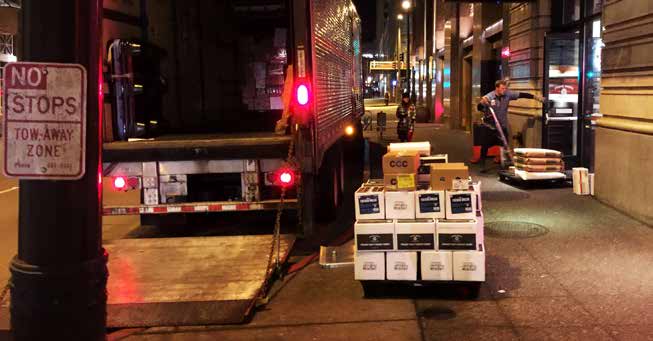Primer for Improved Urban Freight Mobility and Delivery
Operations, Logistics, and Technology Strategies
2. Operations Strategies and Noteworthy Practices

A night-time delivery to an urban restaurant. Source: Chris Eaves, Seattle DOT.
The following section presents five strategies geared towards improving the operation of freight and goods movement in urban areas. Each strategy is profiled as a noteworthy practice, featuring a notable example of the strategy being implemented in the United States or abroad.
Taking steps to better manage curbside loading areas facilitates truck loading and parking, and ultimately improves mobility and traffic flow. Trucks may be required to deliver on a sidewalk when an off-street loading dock or facility is not available, but when curbside areas are limited, they are often forced to circle or double park. Three strategies that can help improve curbside delivery management are: increasing the supply of loading zone space; implementing permitting systems for loading zones; and improving enforcement of loading zone regulations. These efforts are typically led by the public sector at the local level, but they should be developed and implemented in coordination with shippers, receivers, trucking/logistics companies, and local businesses.
City planners and DOTs can also designate and enforce truck routes to manage the flow of commercial vehicles on specific corridors. Designated truck routes can help keep trucks and other large vehicles out of residential areas and limit the damage on roadways or corridors that are not built to support heavy vehicles. Strategies that can help public-sector agencies implement and manage truck routes include: establishing a truck route network, implementing WIM sites for enforcement and data collection, improving enforcement of truck routes, and monitoring vehicle environmental performance. City planners and DOTs should engage with shippers, trucking/logistics companies, industry groups, community development organizations, and other community groups to ensure that truck routes are appropriately designated and limit negative impacts on local neighborhoods and communities.
Lastly, city agencies can improve traffic control and lane management in urban areas to manage truck access in certain neighborhoods or travel lanes. The main objectives of traffic control strategies are to help protect infrastructure in special districts and increase safety. The objectives of lane management are to preserve infrastructure and improve mobility and traffic flow using truck-only or passenger-only lanes. City planners and DOTs at the city or State levels should engage with public and private stakeholders to ensure there are clear alternatives for freight vehicles to any restrictions that are designed to protect local residents and other road users.